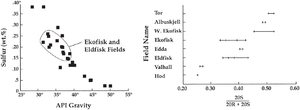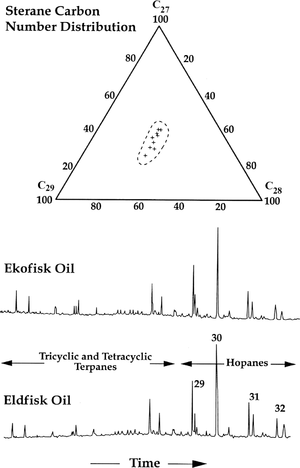Oil correlation case history: Norwegian sector, North Sea
| Exploring for Oil and Gas Traps | |

| |
| Series | Treatise in Petroleum Geology |
|---|---|
| Part | Critical elements of the petroleum system |
| Chapter | Oil–oil and oil–source rock correlations |
| Author | Douglas W. Waples, Joseph A. Curiale |
| Link | Web page |
| Store | AAPG Store |
Commercial oil reserves were discovered in the Norwegian sector of the North Sea more than twenty years ago. Oil–oil and oil–source rock correlations are now reasonably well known and constrained for this region. Early efforts at correlating oils in this area were documented by Phillips Petroleum Co. workers[1] following examination of 30 oils from eight fields. In addition to performing conventional compound-fraction separations and GC and GC/MS analyses, those workers also examined sulfur compound distributions, sulfur and nitrogen contents, and carbon isotope ratios. Their integrated study provides a good example of a modern oil–oil correlation.
Initial evidence suggests several oil families[edit]

The eight fields are in the Central Graben of the North Sea, where the oils occur in Cretaceous and Jurassic reservoirs at 2800–3500 m true vertical depth. The source is presumed to be Upper Jurassic mudstones, based on a correlation of Ekofisk oil to Kimmeridgian source rocks.[2] Initial examination of bulk geochemical parameters in the 30 oils indicated wide compositional variation, as illustrated in the percent sulfur vs. API gravity plot below. Similar variability exists in the nitrogen concentrations and in the distribution of saturated hydrocarbons, aromatic hydrocarbons, NSO, and asphaltene fractions (not shown). Using these data alone, we might conclude that several source-distinctive families exist.
Figure 1 shows data for a set of oils from eight fields in the Norwegian sector of the North Sea. The left figure is concentration of sulfur in oil plotted against API gravity, showing a trend of decreasing sulfur content with increasing gravity. Note that the Ekofisk and Eldfisk field oils show only small ranges in sulfur content and gravity. The right figure shows ααα-20S/(20S+20R) ratios plotted for each of the eight fields. This wide range extends from a decidedly marginally mature oil (in Hod field) to oils in which this parameter has reached equilibrium.
Further evidence shows oils are similar[edit]

Examination of correlation parameters that are more specifically source distinctive, however, suggests that the variations within the set of oils are actually minor. The distribution of C27-C29 regular steranes shows that most of the oils cluster rather tightly, with approximately equal concentrations of each homolog (Figure 2). Furthermore, Hughes et al.[1]) report that δ13C values for the oils range from –28.7 ‰ to –26.8 ‰, with 28 of the 30 oils falling in the –28.3 ‰ to –27.1 ‰ range. Finally, terpane distributions show that many of the oils are very similar to one another (Figure 2, bottom).
The ternary diagram (Figure 2, top) shows the distribution of ααα-20R-steranes by carbon number. The oval encloses all of the samples. The small range for most of the samples within the oval suggests that a single organic source facies could be responsible for most of the oils. In the m/z 191 mass chromatograms (Figure 2, bottom) for a typical Ekofisk and Eldfisk oil, note the peak-to-peak similarity of these oils of similar maturity.
Conclusions drawn from the correlation study[edit]
The wide variation in bulk parameters, in contrast to the similarity in certain source-distinctive parameters, suggested to Hughes et al.[1]) that nongenetic effects could be controlling the bulk geochemical data. Detailed molecular analyses were then used to establish that the variation in bulk parameters arises from differences in thermal maturity among these samples. Figure 8-46 shows that the ααα-20R/(20R+20S)-24-ethyl-cholestane ratio ranges from 0.25 to equilibrium values of 0.50–0.55 for the oils from these eight fields but is reasonably constant within any single field. This finding is geologically significant since oil maturity increases from south to north in the Norwegian sector of the North Sea. This observation in turn suggests northward migration of oil from a progressively maturing source rock to the south.
The maturity ordering proposed by Hughes et al.[1]) in Figure 8-46 is supported by numerous other molecular indices and helps explain the wide variability in bulk parameters. For example, the percent sulfur vs. API gravity trend may exist because the most mature oils have low sulfur contents and high gravities. Indeed, comparing the molecular data with these bulk parameters indicates the maturity trend in the figure is reflected in the sulfur-gravity trend, although some minor source-related differences are present in the sample set. The authors provide further evidence of their conclusions through the use of principal components analysis, which discriminates between source- and maturity-dependent parameters.
What this case study illustrates[edit]
This case study illustrates the importance of emphasizing source-distinctive correlation parameters as well as the value of using many types of geochemical data. Without this wide range of applicable geochemical parameters, the source-related similarities in these oils might have been unappreciated and the various oils interpreted as arising from entirely different source units.
See also[edit]
References[edit]
- ↑ 1.0 1.1 1.2 1.3 1.4 1.5 Hughes, W. B., A. G. Holba, D. E. Miller, and J. S. Richardson, 1985, Geochemistry of greater Ekofisk crude oils, in Thomas, B., M., eds., Petroleum geochemistry in exploration of the Norwegian Shelf: London, Graham & Trotman, p. 75–92.
- ↑ van den Bark, E., and O. D. Thomas, 1980, Ekofisk: first of the giant oil fields in western Europe, in M. T. Halbouty, ed., Giant Oil and Gas Fields of the Decade 1968–1978: AAPG Memoir 30, p. 195–224.